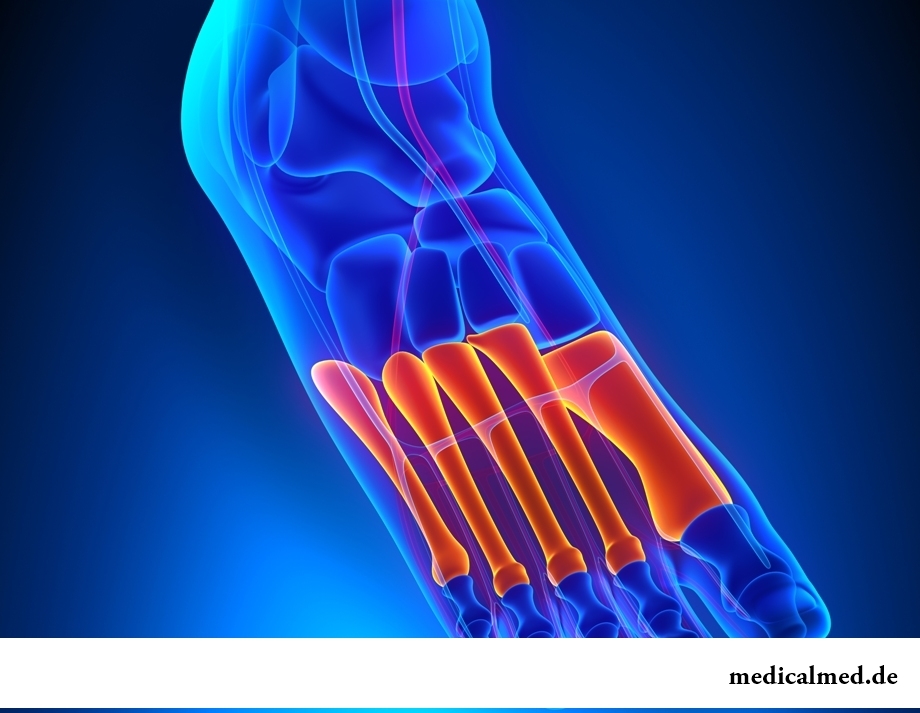





Plusnevy bone
Metatarsus – a part of foot between a tarsal bone and phalanxes of fingers. The metatarsus is formed by five tubular bones.

Structure of a plusnevy bone
Each bone of a metatarsus has the basis of a wedge-shaped form, a body and a head. The second bone of a metatarsus the longest, and the first – the most massive and short. The first plusnevy bone is divided into two platforms. Both platforms of a plusnevy bone are adjoined by sesamoids. The structure of bones of a metatarsus is similar to a structure of metacarpal bones, however heads of plusnevy bones are squeezed from sides and narrowed.
The body of each bone of a metatarsus has three sides, and between sides there are free spaces – interosseous intervals. The joint surface bones of a metatarsus connect to tarsus bones.
At the fifth plusnevy bone the joint facer is located only on one its party (medial). Fifth bone of a metatarsus a little hilly. The sinew of a short fibular muscle is attached to a hilly part of the fifth bone.
The basis of the first bone of a metatarsus forms a joint with a medial wedge-shaped bone. The bases of the second and third bones of a metatarsus are connected to a lateral bone and to wedge-shaped bones. The fifth bone is connected to a cubical bone.
Plusnevy bones form the longitudinal and cross arches turned by the camber up with tarsus bones. The Plusnevy arch is placed around heads of bones of a metatarsus, and tarsal – in tarsal bones.
The arches of foot perform depreciation function when walking and during static loads, and also interfere with damage of fabrics and create conditions for a normal blood-groove.
Shift of a head of plusnevy bones
Proximal phalanxes of fingers and head of plusnevy bones form metatarsophalangeal joints. The joint capsule of a bone consists of the periblast presented by dense fibrous fabric and the inside layer formed by a synovial membrane.
Shift of a head of plusnevy bones leads to an inflammation and further injury of a joint, development of a capsulitis and synovitis. The increased head of bones of a metatarsus becomes covered by calloused skin. Pain in a joint – the main sign of shift of a head of bones of a metatarsus.
Treatment is selected taking into account extent of deformation of a head of plusnevy bones. At initial manifestations of deformation use of orthopedic devices is possible (insoles, interdigital laying, instep supports).
Flat-footedness and valgirovaniye of the first finger allow to eliminate a reconstructive method of an operative measure. Under local anesthesia fixing by metal spokes of the first bone of a metatarsus in the correct situation (a corrective osteotomy), a resection (removal) of the deformed head of a bone of a metatarsus ("cone") is carried out. After surgical intervention to the patient instep supports are attached to a foot.
Fracture of a plusnevy bone
Fractures of a plusnevy bone happen traumatic and stressful (fatigue). The traumatic change (without shift or with shift) can arise owing to a podvertyvaniye of foot or direct stroke. At a fracture of a plusnevy bone without shift fragments of bones keep the correct situation. At a change to shift there is a disturbance of anatomic provision of fragments.
The traumatic fracture of a bone of a metatarsus is shown in a characteristic crunch during an injury, pain in the field of a change, shortening of a finger or its deviation aside. In the field of a change bruise or hypostasis can develop.
Jones's change – one of kinds of fractures of bones of a metatarsus. This change is formed in the basis of the fifth bone of a metatarsus and characterized by failure of union or the slowed-down union. One of kinds of fractures of plusnevy bones is Jones's change. Often at Jones's change sprains make the wrong diagnosis.
Fatigue fracture of bones of a metatarsus – the imperceptible cracks arising because of deformation of foot, osteoporosis, pathological structure of a bone, long repeated loadings.
At a fatigue fracture of a plusnevy bone there is pain after or during loading, pain in the field of a change at a touch, swelled.
In the absence of treatment or at the wrong treatment of a fracture of bones of a metatarsus complications - arthrosis, deformations, failure of union of a fracture, chronic pains in foot can develop.
Treatment of a change depends on its localization, character, and also on existence of shift. Apply the following methods of treatment of a fracture of bones of a metatarsus:
- The plaster immobilization - is applied at a fracture of bones of a metatarsus without shift;
- Surgical intervention.
At a change compare bone fragments with shift, and then fix them implants.
Caries is the most widespread infectious disease in the world to which even flu cannot compete.

Memory is an ability of the central nervous system to fix, keep and as necessary to reproduce information on knowledge...
Section: Articles about health
Smoking not only exerts a negative impact on the state of health of the consumer of tobacco products, but is an air polluter the substances potentially dangerous to people around. In recent years significantly the number of people, стремящ increased...
Section: Articles about health
Sometimes it seems that modern society was divided into two camps: representatives of the first are sure that only the woman has to be responsible for contraception, representatives of the second, respectively, are sure that it is destiny of men. Meanwhile the question of contraception has very many aspects – both psychological, and legal and, of course, medical....
Section: Articles about health
The unpleasant feelings connected with spring breakdown are familiar almost to each of us. Often happens that in March-April on the person...
Section: Articles about health
It is known that the person for 80% consists of water which participates in all processes of an organism. The person loses liquid daily – as a result of sweating, breath, an urination, and its insufficient completion due to various reasons can bring to обезвожив...
Section: Articles about health
(Xerostomia) many people consider feeling of a xerostomia small and easily removable inconvenience. This delusion: the symptom can demonstrate existence of serious diseases. It is worth to remember also that saliva performs important functions in an organism: clears the surface of teeth of a food plaque, growth of pathogenic microorganisms oppresses, normalizes acid-base balance, liquefies food and helps to split the carbohydrates which are contained in it. Chronic deficit слюн...
Section: Articles about health
The problem of diagnosis was and remains to one of the most important in medicine. From that, the reason недо will be how precisely defined...
Section: Articles about health
The winter swimming in open reservoirs called in our country by "winter swimming" – officially recognized sport and one of the most extreme ways of a hardening of an organism. This occupation has an old story and adherents in many countries. Are annually carried out...
Section: Articles about health
Women quite often suffer from complexes concerning the sizes of the bust. Strangely enough, not too modest, and excessively curvy shapes become the reason of sincere discomfort sometimes. Except psychological problems, the big bust sometimes creates also quite notable malfunctions with health: his owner can feel muscular dorsodynias, feeling of constant fatigue and difficulty of breath. Over time excess loading leads to development of diseases позвоночн...
Section: Articles about health
Heart disease and blood vessels lead to disturbance of blood supply of bodies and fabrics that involves failures in their works...
Section: Articles about health
About 20% of the population of our planet have a hypertension (permanent increase in arterial pressure). This disease has an adverse effect on the standard of living, reduces working capacity, and in the absence of systematic treatment threatens with such complications as a heart attack...
Section: Articles about health
Healthy lifestyle today in fashion, and many parents think of that the child from the early childhood played sports. Trainings will help it to become strong and hardy, will improve coordination of movements, and also will exert positive impact on mentality: it will become more collected and purposeful....
Section: Articles about health
Such trouble as the milkwoman's attack, at least once in life happened almost to each woman. Prevalence of a disease is explained by the fact that the causative agent of an illness belongs to the so-called opportunistic microflora living on mucous membranes of any human body and which is becoming more active only under favorable conditions. If you had curdled allocations from a vagina, the itch and burning in external genitals, or painful feelings disturb at sex...
Section: Articles about health
Eyes – one of the most vulnerable areas on a face therefore age changes concern them first of all. Whether it is possible to keep a pier...
Section: Articles about health
Energy saving lamps are one of the most popular products of innovative technologies, and there is no wonder: they much more economic also are more long-lasting than usual filament lamps. At the same time there are fears that energy saving bulbs can become the reasons...
Section: Articles about health
For anybody not a secret that our country is one of the most "drinking" in the world. At clear understanding that the use of hard alcoholic drinks – occupation extremely harmful, most of Russians belong to alcoholism with unjustified loyalty. Apparently, existence of a set of myths in which tendency to excessive libations looks nearly positively is explained by it. It is worth getting acquainted with the most widespread of similar delusions and to be convinced in them not...
Section: Articles about health
History of mankind contains several tens of epidemics whose emergence was compared by eyewitnesses and historians to doomsday. With...
Section: Articles about health
Doctors claim that the people not so familiar with a dorsodynia occur among adult Russians very seldom. At the same time the vast majority of the patients who are periodically testing this indisposition do not hurry to ask for medical care at all. With one St...
Section: Articles about health
About influence of fasting days on an organism it is told much – both about advantages, and about shortcomings. It is considered that fasting day in the form of a short-term monodiet is useful, promoting effective removal of slags from an organism whereas irregular, excessively long, spontaneous fasting days lead only to deterioration in health. How to derive benefit from the sparing diet and not to do much harm to itself? Let's consider the main advantages and shortcomings of fasting days and their influence on an org...
Section: Articles about health
The healthy nutrition is the invariable principle of health and good health for long years of the woman. Nevertheless, in рацио...
Section: Articles about health
Life does not indulge the modern woman special emotional comfort and carelessness. The fatigue, troubles at work, misunderstanding in a family and various illnesses immediately affect a condition of hair and skin. And to look safe and attractive so хоч...
Section: Articles about health
Diseases of joints often begin imperceptibly for the person. The first stages of destruction of the cartilaginous tissue providing soft and free sliding of heads of bones in joint bags proceed slowly and absolutely without serious consequences. Especially unpleasantly for the fact that this process is not connected with advanced age: degradation of joint surfaces is, as a rule, noticeable after 30 years. It means that practically each able-bodied person at any time can face sad results...
Section: Articles about health
Some people consider what for medicine of the 21st century of secrets in the field of health of the person almost does not exist. It absolutely not so. Than Bol...
Section: Articles about health
Small appetite at the child – the complaint which pediatricians should hear practically from each mother. Most often it is carried to the category of children's whims, however the refusal of food in certain cases can be to alarming symptoms therefore it cannot be ignored....
Section: Articles about health
All are familiar with cold, and practically everyone believes that he has sufficient knowledge and experience that correctly to treat it. In practice most of people makes mistakes in attempts to get rid of rhinitis, and divides numerous delusions it....
Section: Articles about health


